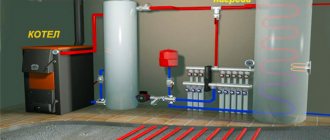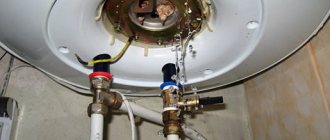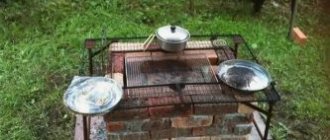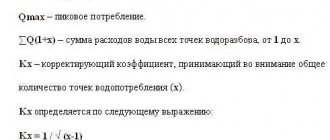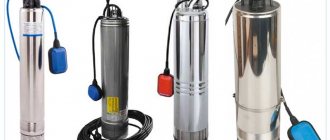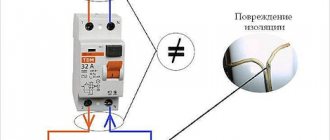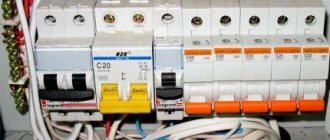The tank must compensate for the thermal expansion of hot water in the boiler when heated.
During expansion, water should go into the tank, compressing its air part, so that the pressure in the boiler grows slowly and does not exceed the safety valve response threshold.
And here the air has leaked out, the entire tank is filled with water, there is nothing to compress, there is nowhere for the water from the boiler to expand.
The pressure quickly exceeded 6 bar and the valve was regularly triggered, releasing some of the water.
After several dozen such discharges, the safety valves begin to leak.
And then the caring installers diverted the discharge into the sewer.
The user does not understand at all what is happening, some kind of miracles.
Now do you understand how important it is that there is enough air in the tank for the system to operate smoothly?
I recommend taking just 10% of the boiler volume. If this is definitely not the case, then take the next volume in the line.
Boiler 100 liters - take tank 12.
Boiler 150 liters - tank 16, boiler 200 liters - tank 24 liters.
The tanks come from the factory at 2.5 bar. Some people set it exactly like this, others lower it to 1.8 for some reason.
Air must be pumped into the tank based on the pressure of cold water.
For example, 4 bars comes into the house from the central water supply or from a well.
Create a little more air pressure in the tank, for example 4.2 bar.
If you leave 2.5 bar in the tank, then after connecting the tank to the system, cold water will compress the air in it to the same four bars, and the working volume of air will decrease by almost half.
And if the tank is pumped up to 4.2, then the entire volume of the tank will work and will begin to work only with the beginning of real expansion of the water.
And so there are three rules:
- Take a tank of at least 10% of the boiler volume.
- Set the initial pressure in the tank to 0.2 bar more than in the cold water pipeline.
- Never dispose of waste into a sewer. Lead the tube into a jar or bottle to immediately see that the tap is spitting and pump up the tank in time.
Design
The expansion tank ensures reliable, long-term operation of the water supply system. There is a large selection of devices. To understand what you need, you should at least have some idea of how the tank works. The purpose of the expansion tank is to maintain operating pressure. They use a tank with a pear-shaped membrane (diaphragm) made of rubber. It divides the capacity into parts: air-water. The water chamber is filled with liquid under the action of an electric pump after the system starts operating, and the heated water pushes through the membrane. As a result, the air part is reduced - the pressure is adjusted. More pressure in the pipeline means more water in the tank. When cooling—the volume of liquid decreases—the membrane, under gas or air pressure, expels water from the tank. The pressure level is usually monitored by a pressure gauge. This helps to control and regulate the operation of the system by setting the necessary pressure limits.
Other possible parts of the expansion tank: flange, nipple, connections, hydrodynamic shock compensator, separating glass, membrane rupture alarm, various fittings, mounting brackets, brackets.
The expansion tank for water supply solves other problems of uninterrupted operation of the system:
- protects the water supply from water hammer, which can be caused by power surges or air penetration;
- a certain volume of water remains under pressure (minimum tank - 10% of the boiler volume - 10-20 l);
- protects the pump from increased loads and damage.
Installation in a closed heating system
According to experts, such a device can be installed at any point in the heating system, but it is best to attach the expansion tank to the pipeline in front of the circulation pump.
The container can be installed in any position, but the upper location of the air chamber is considered the best option. In this case, the air bubbles will tend to the top. They will not get into the coolant, which will prevent emergency situations even if the gasket is damaged. A special valve is provided to remove accumulated air in a closed heating system.
The device is fixed to the pipe using fittings on the tee, a tap is installed in front of the tank and after. It is necessary for checking and servicing the device before starting the heating system. To determine the serviceability of the container, turn off the tap, turn on the heating and observe the readings of the pressure gauge.
When the arrow reaches one, open the valve and look at the pressure gauge dial. If the tank is working properly, the pressure should drop to 0.2 atmospheres. This is due to the displacement of excess fluid.
During operation of the heating system, cases arise when the volume of the compensation tank is not enough for efficient heating operation. In this case, there is no need to remove the tank and replace it with a larger reservoir. It would be more advisable to install additional capacity.
Connection diagram for an expansion tank in a closed heating system
If the expansion tank is installed in a heating system with natural coolant circulation, then a steam valve is required. The main task of such a device is to relieve excess pressure that occurs when the liquid is heated above the recommended temperatures.
What types of expansion tanks are there?
Depending on the membrane, expansion tanks are divided into types. In the first, the membrane is replaceable - if necessary, this most vulnerable part can be removed to be replaced with a new one. This type of tank is also different in that the water is inside the membrane, that is, it does not come into contact with the inner walls. The solution protects the metal from destruction, and water from accidental contamination, spoilage, and odor, which has a positive effect on its hygienic qualities and extends the service life of the unit.
In tanks of the second type, the membrane is fixed strictly in one place and cannot be removed. This membrane cannot be replaced. Damage to it will entail the need to replace the tank, which will require additional costs, often unforeseen. Another disadvantage of such tanks is the direct contact of water with the walls of the container, which affects the condition of the metal and corrodes it. To avoid this, the inside of the tank walls are coated with a special compound, although such protection does not ensure exceptional durability of the device.
Tanks are available in horizontal or vertical layout - the choice is determined by the chosen installation location.
Adjusting the hydraulic tank in the water heater trim
There is one peculiarity here. Such hydraulic tanks should have a slightly higher operating air pressure, namely 0.2 bar higher than what is written in the instructions.
So, if the pump produces 3.5 bar, the hydraulic tank is adjusted to 3.7 bar. The first performance check and adjustment is performed before starting the system, until the container is filled with coolant.
The absence of liquid in the chamber is normal operation. And it fills only when the water in the pipes heats up. Lack of air pressure in the expansion tank leads to the coolant filling the tank, which is a violation of operational requirements. In this case, it is necessary to turn off and drain the system, and then adjust the hydraulic tank again.
What to look for when choosing?
Experts advise installing an expansion tank with a volume of 10% of the volume of the hot water boiler: a 100-liter boiler requires a 10-liter tank, a 200-liter boiler requires a 20-liter tank.
It is important to consider that a smaller capacity means the possibility of more frequent pressure surges. Do not forget that water is stored in the tank. This reserve may come in handy under certain circumstances.
You need to select a special hot water supply tank, for which such a possibility is provided structurally, indicated in the instructions. For example, heating system tanks require higher operating temperatures, but lower pressures. They provide the transfer of coolant at a “hotter” temperature, but the pressure there is relatively low. In such containers, little attention is paid to the hygienic characteristics of the materials. To help the consumer, tanks are made in different colors: blue, blue, white for water supply, red for heating. But it’s better to carefully read the product data sheet to avoid mistakes, since you can’t always trust the labeling.
The safety of using an expansion tank for water is determined by the material of the membrane and tank:
- rubber of natural origin - harmless in cold water, but you should not heat it above 50 degrees - negative reactions are possible;
- artificial rubber is suitable for water of various temperatures - up to boiling - without any consequences;
- rubber (ethylene-propylene) is similar in properties to artificial rubber - it has high performance properties;
- The tanks themselves are most often made of steel.
Another factor in choosing a tank is the manufacturer. A low price can often mean low quality of the product and, as a result, subsequent expensive repairs. A manufacturer with a name and reputation is not ready to sacrifice them, chasing fleeting benefits. They offer tanks and good quality components at reasonable prices. First of all, pay attention to the membrane material (see above), since the service life of the tank, the quality and safety of the water depend on this. The price of the membrane is not an empty question if we are talking about a tank with a replaceable rubber band.
Electrical connection diagram
The combined version of the tank, equipped with a heating element, must be connected to the house electrical network, taking into account the transition to summer mode, in which the main coil will no longer receive heat from the boiler. We suggest using a universal circuit that includes a pump control module via a thermostat.
The colors of the wires shown in the figure correspond to the generally accepted classification: blue - neutral, brown - phase, yellow-green - ground, and so on
The circuit involves a second safety thermostat, which is activated when the sanitary water overheats. The indicator lamp signals that the heating element is turned on.
How to install?
When installing an expansion tank for water supply, it is important to know:
- the tank is mounted in such a way that it is easy to maintain and pipes are easy to change;
- the diameter of the pipes connected to the tank is selected not less than the diameter of the tank pipes;
- the equipment must be grounded;
- There must be no obstacles or elements that interfere with the standard pressure between the pump and the connection point.
The liquid flows to the boiler through a valve, which prevents the release of hot water into the cold water supply system. The tank is installed between the boiler and the valve. This way, hot water will come straight from the tap. Sometimes the tank is mounted after the boiler, but then cold liquid from the tank will first flow into the hot water supply.
Causes of pressure drop
Despite the fact that the pressure in the tank should be constant, it often drops during operation of the heating system.
There are a number of reasons why blood pressure drops:
- Coolant leak . Such problems usually appear in heating systems operating on antifreeze, which can penetrate even small cracks. As a result, leaks occur. They must be eliminated before pumping the expansion tank in the heating system with air.
- Reduced pressure in the boiler . If it falls significantly, you should contact the experts. If the pressure has not dropped critically and has leveled off after starting the system, then it can be used, since such failures cannot harm it.
Types of double-circuit gas boilers with a built-in boiler: are they needed?
Boilers are used in conjunction with single- and double-circuit gas boilers. In the second case, the unit itself works only for heating. There are free-standing and built-in boilers.
The former are often purchased separately, have a large capacity, and are suitable for single- and double-circuit devices of open and closed type. Requires complex connections.
Built-in tanks are part of ready-made solutions based on double-circuit boilers. They are compact due to their small volume, are equipped with advanced automation from the factory, and can be easily connected.
Important! The volume of a free-standing boiler is selected in proportion to the boiler power. If the tank is too large, then the water in it will not warm up to the required 60 °C according to sanitary standards.
This is fraught with the appearance of legionella colonies that are hazardous to health.
Modern devices with built-in storage devices have an anti-legionella function: the boiler automatically warms up to 65 °C for 30 minutes from time to time, thereby killing harmful bacteria.
Double-circuit gas boilers with boilers differ in location, type of storage tank and its capacity.
By location: floor-mounted non-volatile and wall-mounted
Floor-standing, non-volatile boilers are large in size and have high power. The mass of the heating device without liquid reaches 100 kg. They are equipped with built-in boilers with a volume of up to 120 l, external mounted or floor-mounted - 50–500 l.
Photo 1. Floor-standing double-circuit gas boiler with an indirect heating boiler, installed in a special room.
They often require placement in a specially equipped boiler room. They heat and supply water quickly, but are sensitive to power surges. They create problems when connecting the recirculation system.
Wall-mounted equipment is smaller and weaker than floor-mounted equipment. Does not require the arrangement of a separate room; it can be installed in bathrooms and kitchens. They are usually equipped with built-in indirect heating tanks with a capacity of 10–60 liters with constant heating of the liquid by a secondary DHW circuit.
They are less often connected to free-standing boilers of similar volume. Their heat exchangers have a small internal cross-section, which is why the devices are afraid of scale and are very sensitive to water quality.
Boiler type with electric heater
The direct heating boiler is equipped with its own heating element, which independently increases and maintains the water temperature. Often this is a tubular electric heater (TEH), powered by mains or gas. Installation of the second option also requires permission from regulatory authorities.
The DHW system can be based solely on a directly heated storage tank, bypassing the connection to the boiler.
Indirect heating boilers do not have their own active heating element. A coil is placed in the water tank, which passes coolant through it, previously heated in another heating device. They are installed with gas equipment with a power of 25 kW or more; for the automation to work, a connection to the network is required.
Photo 2. A double-circuit gas boiler with a combined boiler heats the water in the tank due to the operation of the coil.
Combined boilers have a coil that operates on an indirect principle and a heating element that directly heats the water in the tank. The working element maintains the temperature at the required level, but most of the heating is provided by the coil.
Reference! Combined drives are suitable for single- and dual-circuit low-power equipment. They reduce electricity consumption during the heating season, providing the necessary water heating throughout the entire service life.
Features of operation, troubleshooting
The walls of a properly functioning boiler are at room temperature, the device does not make noise, does not consume electricity beyond what is specified in the passport, and warms up in 20–30 minutes.
Prolonged heating indicates that scale or debris has accumulated in the tank. The problem is solved by mechanical or chemical cleaning. Both require draining the water and dismantling the tank.
For the first, the boiler is disassembled, the walls and heating elements are cleaned manually. No disassembly is required for dry cleaning.
The removed storage tank is turned over, a solution of citric acid or anti-scale agent is poured into the cold water inlet pipe, and the boiler is left in this form for several hours. Then the cleaning liquid is drained, the container is mounted in place and washed with water.
A hot boiler body indicates depressurization of the container due to microcracks. It is impossible to fix the problem yourself; repair or replacement of the device is required.
Hydraulic tank maintenance rules
Hydraulic tank maintenance rules.
Installation, testing and repair of equipment must be carried out in accordance with the manufacturer's recommendations by specialists who have undergone special training.
Any changes to the design of the expansion chamber using welding or mechanical influence are prohibited.
Once a year it is necessary to perform a preventive inspection of the hydraulic tank:
- Check the pressure in the air chamber.
- Carry out an external inspection of the installation body.
- Inspect control and measuring equipment (pressure gauge, valves, relays, etc.).
- Inspect the tightness of pipelines and the operation of shut-off valves.
Wall mount
Instantaneous water heaters are lighter, so they are easier to mount on the wall in an apartment. But heavy boilers, which are designed for a water volume of 50 to 200 liters, must be very well attached to the wall.
This is where the installation of the boiler with your own hands begins. Installation can only be carried out using anchor hooks or bolts. Such fastening will be reliable on concrete panel walls or solid brick walls.
But if the wall does not inspire confidence in you: wooden or old brick, then you need to drill through the wall and screw it onto steel strips from behind. Or make a metal frame on the wall and attach it to it using hooks welded to the frame. Well, in general, such a boiler cannot be hung on a plasterboard wall in an apartment.
When installing any water heaters, you must hang them strictly vertically, determining the accuracy of the mounting level. If the boiler hangs unevenly, with a slope, then there will be problems with its operation.
Another nuance that must be taken into account when installing it yourself is that the distance from the shelf to the boiler lid must be left about 15 centimeters.
The video shows in detail how to install a boiler with your own hands:

